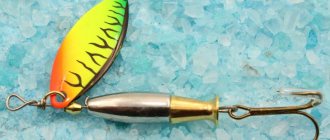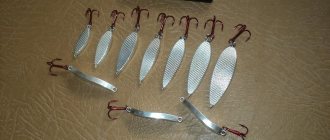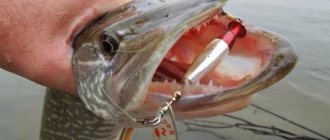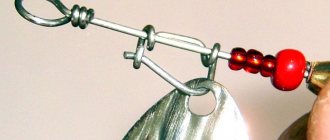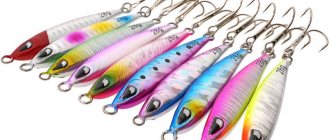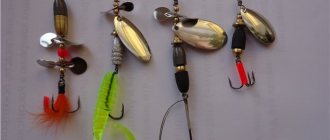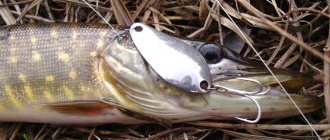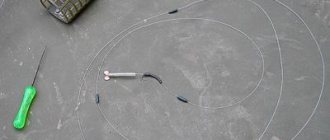What's happened
A spinning spoon is a fishing bait that practically does not resemble the fish that a predator hunts, but, nevertheless, is extremely catchy. Its catchability lies in the fact that when rotating it:
- emits strong acoustic vibrations;
- creates a magnetic field in water;
- quite often creates a noticeable visual outline.
All this adds up to make predatory fish attack the bait.
The principle of operation of a rotating spoon is that when reeling, its petal begins to rotate, creating the above effects.
pinwheel petal
The main part of any spinner is the petal. His work ultimately determines the catchability of the spinner. When I started making spinners, there was a big problem with good spinners. I started by copying Mepps turntables. I didn’t have a stamp, which is probably why the copies weren’t very successful. I decided to make my own options. The result was a petal that I still use in my homemade pinwheels.
The petals of most industrially produced spinners have a “regular” shape - a derivative of a sphere, cylinder and cone. When rotated, it creates relatively uniform, “monophonic” vibrations. And the surface of my petal has at least four distinct areas, plus an additional convexity, and part of the surface is slightly concave. It may not be very attractive to look at, but when rotating in water, the waves from the “edges” of such an “irregular” petal create real “polyphony”, which the “correct” industrial petal never has.
The material for the petal can be any non-ferrous metal. Most often I use cupronickel, brass, and beryllium bronze.
When choosing the thickness, it is necessary to take into account that a thicker petal rotates more slowly, and very thin ones are too unreliable in operation: it happens that a pike crushes the thin petal of the pinwheel when gripping it. From experience I can say that the optimal petal thickness is 0.4–0.45 mm, in extreme cases 0.5 mm.
I never make pinwheels in batches, so I don't use any stamps. I knock out the bend of the petal with a ball from a large bearing. At the same time, the metal is cold-worked, and this secures the profile given to the petal. In the middle of the petal I make a small bend, which allows me to change the angle of deflection of the petal while fishing.
If you reduce the bend angle, make it sharper, the angle of deviation of the petal from the axis will decrease, and the rotation speed will increase. If you straighten the petal, making it flatter, the deflection angle will increase and the rotation speed will decrease.
A dispute often arises among fishermen: should the blade of the spinner be polished or not? I rarely polish the petals myself. The fact is that any metal is covered with an oxide film. If you need to make the pinwheel brighter, just take a little sand and rub the petal. This does not give a bright polish, but a natural shine to the metal. The exception, perhaps, is cupronickel, which darkens a little in water.
The polished cupronickel petal soon fades and acquires a golden hue. Under no circumstances should you clean it off: I did it once, and then I regretted it for a long time. But all this applies only to the outer side of the pinwheel petal; in any case, the inner side cannot be polished
Advantages and disadvantages
Turntables have the following advantages:
- they are extremely catchy in most reservoirs of our country;
- with their help you can successfully catch most species of predatory fish that live in domestic reservoirs, as well as “white” predators and some “peaceful” fish;
- fishing with them does not require expensive gear;
- learning to fish with a spinner is much easier than with other baits;
- easy to make with your own hands;
- have a much lower cost than many other fishing lures.
The disadvantages of rotating spinners are the following:
- twist the line when retrieving, if fishing without a swivel;
- are of little use in places with a large number of hooks;
- Fishing with spinners is not very creative due to the nature of their design.
Basic models of front-loaded turntables
Spinners with a weight-head are much less common in the world than spinners with a core. Well-known companies usually produce only 1-2 “big-headed” models. The most famous spinners are “Morrum” (Fig. 1), “Lusox” and “Erie Dearie”, as well as some other options.
Lusox
The MEPPS Lusox spinner (Fig. 2) is designed for catching pike in quiet and deep places.
Fig.2. Spinner MEPPS Lusox.
Therefore, it has a special easy-to-play petal for the slowest retrieve. But the “native” sinker of this spinner is relatively light, so it only works in forward motion.
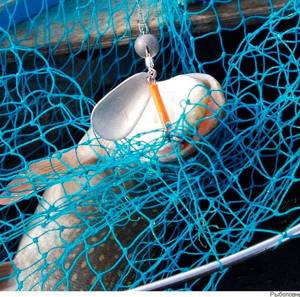
Erie Dearie
The American spinner “Erie Dearie” (Fig. 3) was created specifically for catching pike perch near the bottom.

Fig.3. Erie Dearie spinner.
That's why it has an oversized weight with a massive front for step retrieves, as well as a single hook to reduce the number of snags.
Design
The most complex design is a rotating spoon with an axial core.
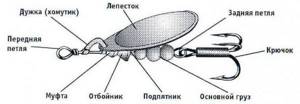
It consists of an axle, at the ends of which there are loops for attaching the main line and tee. Above the tee there is the core itself, then there is a thrust bearing, a bump stop and a coupling, which ensure free rotation of the petal and produce certain sounds when the spinner is operating. The next part is the clamp on which the petal is attached. The clamp is also responsible for the free rotation of the petal.
Design features of baits
Spinner spinners have a more complex design compared to oscillating spinners. The classic version of this bait consists of the following elements:
- Petal. It is fixed by a movable connection on the axis, and it is the features of its geometry that most determine the play of the spinner, and, consequently, its catchability.
- The main rod or axis. All other structural elements are mounted on it, which places special demands on its strength.
- A bow or clamp with which the petal is attached to the axis. Not only the smooth movement of the petal, but also the likelihood of it jamming depends on the shape of the bow.
- The core, or body of the spinner, often also serves as a sinker, although it can exclusively increase the visual volume of the bait.
- Bumper. It is located between the bail and the core and is needed to prevent the line from twisting. It also prevents the petal from jamming.
- Loading. It can be located in different ways - in the front of the spoon, in front of the petal, behind it, or even as close as possible to the tee. Some turntables have no load at all.
- Treble hook. It can be attached either directly to the axle or through a winding ring. Often decorated with wool threads, multi-colored shrink tubing or lurex for added appeal.
What fish are they used for catching?
The list of fish that can be caught on spinners includes:
- Pike.
Pike can be caught on spinners of any design and in any conditions. The only obstacle is the hooks: in snagy places they can’t catch with spinners. - Perch.
Perch are crazy about spinners. At shallow depths, it is better to catch it with baits with an axial core of size No. 1-No. 2, although even small striped robber is not missed by spinners of No. 4. At depths, front-loaded spinners and tail spinners are more suitable. - Pike perch.
To catch pike perch, front-loaded spinners are used, which should be fished with jigs. But they are not widespread, since the predator often prefers places with various shelters, and spinners and hooks are incompatible things. And it bites better on silicone. - Bersha.
Catching bersh on front-loaded spinners is more promising, since this younger brother of pike perch lives on a clean bottom. - Chub.
Chub are successfully caught on spinners with an axial core with a petal on a clamp and in-line. Use those spinners that hold the stream well, i.e. usually baits with a narrow blade. - Yazya.
Ide is not a fan of fast jets, so it can be successfully caught on spinners with Aglia and Komet petals. - Asp.
The fast-moving river predator is caught using long-range spinners that operate stably in strong currents. - Grayling.
For grayling, the spinner is bait number 1. This inhabitant of clear waters prefers small baits. - Trout.
Wild trout can be caught on a variety of spinners. Pied is partial to black and Black Fury . - Bleak.
Bleak is caught purposefully with ultralight tackle on spinners No. 000, which have a mini-propeller instead of a petal.
Features of loading turntables
Actually, there are three main options for loading rotating spinners:
- Back-loaded. Such spoons are most often found on sale and are also often made by anglers themselves. They have good flight qualities due to their compact design. The shape and color of the core of such a spinner, which usually also serves as a sinker, serves as an additional provoking factor. Overlaps of the tee over the leash of spinners with such a loading arrangement are rare.
- Front loaded. The sinker is located in front of the petal; often such a design implies the ability to quickly replace it. Thanks to this arrangement of the load, the flight characteristics of the spinner are good. Spinner spinners with such a load are excellent for jigging and fishing at great depths, but you should remember that the hook over the leash is most common in such spinners.
- Unloaded. They begin to work already when immersed, but it should be borne in mind that this is the most difficult type of rotating spinner to make independently, since for proper play they often require a rather complex petal shape. Due to the lack of cargo, flight performance is mediocre.
Comparison with other types of baits
A comparison of spinners with other baits is shown in Table 1
Table 1 - comparison of spinners with other baits
| Turntables | Oscillators | Silicone baits | Wobblers | |
| Catchability | High | High | High | High |
| Application area | Everywhere where there are no holds | Everywhere to a certain depth | Everywhere | Under certain conditions |
| Aerodynamics | Average | good | Varies depending on installation | Average or bad |
| The need for specialized gear | Absent | Absent | Mandatory | In many cases |
| average cost | Low | Low | Medium or low | Medium or high |
Fishing technique
The technique of catching perch using a rotating spoon includes the following features:
- The first thing a fisherman should know – this is about wiring, since almost the entire result of the catch depends on it. Slow wiring is considered the most effective. It is done this way:
- The spoon must be cast at a very slow speed so that the petal barely moves.
- At the same time, barely noticeable vibrations are transmitted to the end of the fishing rod, and the overall stroke of the bait is practically without stop.
- You shouldn’t make quick jerks with this type of fishing, as this can scare the fish.
- The second wiring method is wavy wiring. It is used to catch very active predatory fish. It needs to be done very carefully, without losing the pace. In this case, the spinner must be carried out either quickly or slowly, and thus it will fall lower or higher and attract the attention of the fish. It is important that with this wiring method the main line does not sag, as this can lead to malfunctions of the petal.
- The third method is step wiring. It is used when you need to “jump” over a problematic bottom (with holes, ledges, etc.), since ordinary even wiring in this case will not be effective. When doing this, you should lower the spoon into each suitable hole, and then with a sharp movement make a jerk and continue further wiring.
- The fourth method is twitching. It is used in almost the same way as for fishing with wave-like wiring, only with it you should make a uniform reeling with the reel, and at the same time make additional light jerks with the fishing rod.
As for casting, since spinners, as a rule, are light in weight, casting them is not difficult. The main thing you should know is that after the spoon falls to the bottom, you should wait until it lands accurately, and only after that you need to make a small jerk with the fishing rod and start retrieving.
Selection rules
When coming to the store to buy a spinner, an angler should know three things : what kind of fish he will catch, in what conditions he will have to fish, and whether the cost of the spinner corresponds to his financial capabilities. The main criteria that should be followed when choosing a turntable are the following:
Size or number
At first glance, the larger the expected catch, the larger the spoon should be, but in reality this is not the case. Firstly, you need to consider the capabilities of the gear: will it cope with casting and retrieving a large bait, and if not, then choose a lighter and less stubborn spinner. In addition, even large fish sometimes bite better on small baits. For the most common fish we have, we can recommend the following sizes of spinners:
- for pike – No. 3-No. 5;
- for perch - No. 1-No. 2;
- for chub - No. 1-No. 3;
- on ide – No. 2-No. 3;
- for grayling – No. 00-No. 1+;
- for trout - No. 00-No. 3.
By color
With regard to color, there are well-known, but by no means immutable rules:
- active fish, clear weather, muddy water – spinners of bright acidic colors;
- passive fish, cloudy, clear water - baits of natural or dark color.
Expert opinion
Knipovich Nikolai Mikhailovich
Zoologist, hydrobiologist. I am interested in fishing at a professional level.
Interesting! Some fish have certain preferences, for example, chub is partial to dark red and black baits, and trout are crazy about Black Fury - a spinner that has one side painted black with yellow or red round spots. Spots on the petal also affect catchability when fishing for pike and perch.
According to the material of manufacture
High-quality turntables are made from non-ferrous metals and alloys - brass, copper, bronze, cupronickel. Due to this, they are attractive to fish. Ferrous metal fakes are not so catchy.
By manufacturer
It is better, of course, to purchase spinners from well-known manufacturers, but now even the Chinese can not only make a very catchy copy, but also create something original.
By hooks
Unfortunately, many world-famous spinners are equipped with tees of poor quality. Hooks rust rather quickly, become dull, and their strength is very questionable. This applies, first of all, to all European manufacturers. There are no complaints against the Japanese and there cannot be any. Therefore, it is better to immediately change the VMC or Mustad to Owner or Gamakatsu .
By petal size and pinwheel weight
It is easy to notice that spoons of seemingly the same size have different weights, which is usually indicated on the product packaging. The weight of the pinwheel depends not only on the size of the petal, but also on its thickness, and the core can not only have a different volume, but also be made of different metals. For example, craftsmen make spinners with a tungsten core for long-distance casting and retrieving at greater depths.
How to make your spinner better than a branded one?
Let's talk about some additional measures that will make your spoon even more catchy and even “the very best”. You can improve the petal, sinker and tee, or you can improve all these elements at once.
Petal improvement
The petal is the main part of the spoon. If you have a stamp, you can use it to create petals with different patterns, changing only the thickness and hardness of the material. For example, a thinner petal will rotate easier and more stable, and a stiffer material can be used to maintain strength.
MEPPS branded petals are made of brass 0.60 mm thick, which is quite rare in our country. Therefore, homemade workers often stamp similar petals from thinner material - 0.50-0.55 mm. However, such “refined” options can rotate even more easily than branded ones and operate on even slower wiring. This means they can seduce the laziest fish.
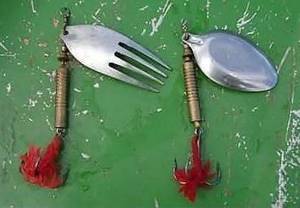
The game of the petal can be changed in your favor in many ways. We have already talked about reducing deflection, and this can and should be used skillfully.
Another good way is filing.
Almost all models of petals can be conditionally divided by appearance into 3 groups: “plate”, “spoon” and “leaf” (Fig. 1).
Fig. 1. Types of petals: a) “plate”, b) “spoon”, c) “leaf”.
The last two varieties are especially easy to change by filing. Let us remember that the play of the petal is influenced by its shape, or rather, the ratio of length and width. Relatively long petals rotate more slowly and with less spread, and vice versa. Therefore, if you remove a layer of metal from the sides of the petal with a file (Fig. 1c), you will get a similar petal with an even narrower and slower play. And if you remove such a layer from behind (Fig. 1b), then the petal will sparkle more easily and widely.
As you can see, a file can come in handy when fishing, especially on long trips. I remember that on the northern Umba River, grayling and salmon periodically came out for a quick riffle. The current was strong, so even the narrowly playing turntable “Aglia long No. 2” was carried to the surface, and the playing of the petal was too fast. The fish stayed near the bottom and did not rush at the bait going on top.
But it was enough to remove 1-2 mm from the sides of the petal with a file so that its play would slow down to “normal” and the lure would no longer be brought to the surface. Which is what was required in specific conditions, and the excellent bite was the main confirmation of this.
You can try to make an acoustic petal, although here you will have to act at random. It is possible that the result will be the opposite, so when experimenting it is better to focus on already known successful samples (Fig. 2).

Fig.2. Acoustic lobe options.
If we want to change the play of light, we will have to process or paint the surface of the petal. For example, on smooth metal you can apply various lines with a regular needle or with an end brush - “frosty” patterns (Fig. 3).

Fig.3. Treatment of the surface of the petals: a) drawing lines with a needle, b) drawing patterns with a brush.
Such petals provide a diffused play of light and are preferable in many cases.
Coloring the petals with dots or stripes can also help (Fig. 4).
Fig.4. Petal coloring options.
You just need to remember that the petal rotates, and the drawn pattern will look different when rotated. I personally like the coloring with red, white and black dots or side “teeth”. For example, MEPPS specialists believe that blue dots are preferable for an active predator, and red dots for a lazy one.
In any case, a contrasting pattern on the petal is useful. After all, there is an opinion that under different conditions fish see some colors better, some worse. So let there be at least two of these colors.
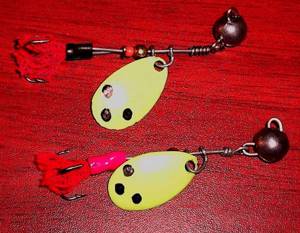
With polarized glasses you can often see a predator attacking a lure. According to my observations, pike attack the spinner from behind in 80% of cases, from the side in 20% of cases, and never from the front. If we take into account that the average spread of the petal is 45°, then when attacking in the rear sector of 90°, the predator does not see the outer surface of the petal at all, but only sees the inner one (Fig. 5).

Fig.5. Zones of visibility of the petal surfaces by the predator.
According to this theory, it can be assumed that for the “detection zone” a brighter and more noticeable color is preferable, and for the near “attack zone” a more familiar and muted color is preferable.
Thus, the “two-sided” theory preaches “outer brilliance and inner modesty.” Specifically, a two-color petal, the outer surface of which is bright, shiny and contrasting, and the inner surface is almost invisible.
Indeed, during the detection phase, the spoon is positioned sideways or even in front of the predator, sometimes at a considerable distance. And here, to attract his attention, the brightest outer surface of the petal is required.
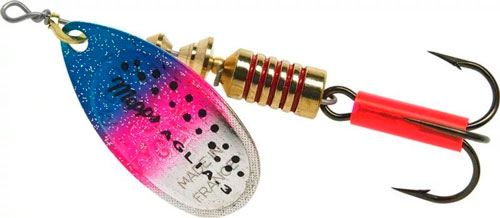
But let us remember that the vast majority of modern spinners have a semblance of a body. Despite the fact that the main sound stimulus is the petal, the predator does not grab it, but rather the body to which the hook is attached. This means that when a predator rushes to the bait and catches up with it, it finds itself in the rear sector of the attack, where it no longer sees the outer surface of the petal, but only the inner one. Therefore, at close range, the petal, or rather its light play, should distract the fish’s attention from the body of the bait as little as possible.
This assumption is also supported by the “color” theory of spinners, according to which the greater the illumination, the darker the spinner should be. Indeed, the less glare and light play the petal gives (in this case, its inner surface), the less it distracts the attention of predators from the main detail - the relatively motionless body.
How to make a petal two-color?
For the copper and brass version, you can polish the outer side to a shine and leave the inner side untouched. It is advisable to scratch the inner surface of a chromed or nickel-plated petal with sandpaper. I prefer silver-plated petals, in which the inner surface is ground until the original material - brass or copper - is exposed.
There is another argument in favor of the dull inner surface of the petal: its concave side, like a mirror lens, can focus light rays at some point and “blind” the fish, scaring it away from the bait (Fig. 6).
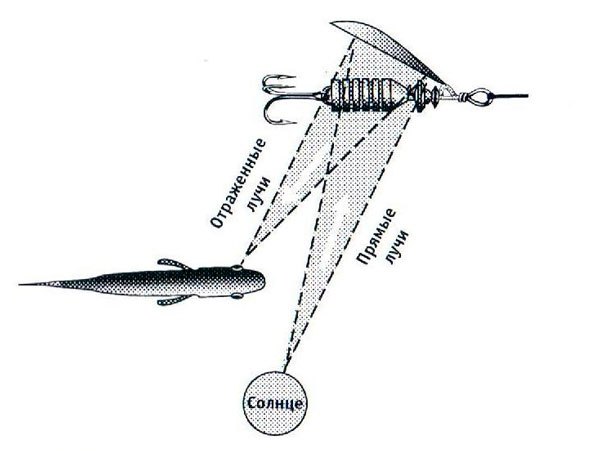
Fig.6. Focusing light rays by the inner surface of the petal.
True, the probability of this is small, but it increases noticeably if the predator attacks from its favorite position - from the sun. This is just an assumption, but I have had cases more than once when a pike, catching up with a spoon, unexpectedly stopped exactly at the point of possible blinding.
From the farthest reaches, the fish will see the spinner if “flex” - a self-adhesive reflective film - is glued to the petal. Such stickers are available in all colors and shades: from acid yellow to almost black - and with different patterns. As a rule, small petals require a small pattern, and vice versa.
But still, you shouldn’t get carried away with the brightest stickers. As a rule, the more light there is and the more careful the predator, the darker the color of the “flex” should be. So, on a clear sunny day, perch prefers a spinner with a red or orange sticker, and asp or pike perch - with a blue or gray one. If the sticker is matched to the color of the petal, the light play will be monochromatic. But a contrasting “flex” is often used - such a spinner “flickers” more.
I prefer a small pattern: dots or “honeycombs” - spinners with such stickers seem to flash with small sparks when rotated.
Some options for using reflective stickers are shown in Fig. 7.

Fig.7. Use of reflective stickers.
Before gluing the film, it is advisable to degrease the surface of the petal with alcohol or acetone, and it is a good idea to heat the petal itself with a hairdryer. Flat or slightly curved surfaces can be glued with “flex” almost entirely; only small pieces or narrow strips can be glued to strongly convex petals.
And finally, a couple of installation tips.
Before placing the petal on the spoon, carefully inspect it and the bow, grind off the burrs, you can even round off the sharp edges. Countersink the hole for the bow and sand it. It is advisable to round the working part of the bow, then the “bow-petal” connection will become freer, and such a petal will play better.
To reduce friction under the bow, and sometimes between the parts of the sinker, experienced craftsmen also install thin fluoroplastic washers.
Sinker improvement
Let's first consider spinners with a sinker-core as the most common.
Their main disadvantage is their relatively low weight, which does not allow them to make long casts. Is it possible to further increase the weight of the core while maintaining the performance qualities of the spinner?
Here we will encounter such an unpleasant phenomenon as “sticking” of the petal. After all, any sinker with its own weight pulls the rod down, and the spoon seems to sag at a certain angle (Fig. 8).
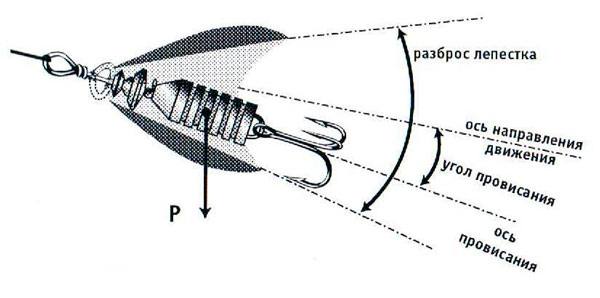
Fig.8. Sagging of the sinker when guiding a rotating spoon.
The heavier the sinker and the more its center of gravity is shifted towards the hook, the more the rod will sag.
The petal works from the action of the oncoming flow of water - which means that its rotation mostly occurs not around the sagging axis, but around the axis of the direction of movement. But the petal still needs to unwind - in a few revolutions, “gain” the angle of rotation from the minimum to the working one.
Therefore, at a certain weight of the sinker, the sagging increases so much that the petal “sticks” at the lowest point, that is, it touches the sinker and cannot begin to rotate.
Let's call the weight of the sinker at which “sticking” occurs at normal moving speeds critical. It is clear that the core that we are going to install on a particular petal must weigh less than the critical one.
How much less? If we take a sinker a little lighter than the critical one, we will see that the petal no longer sticks tightly, but does not “turn on” well. You first need to pull it up, “start it up” and make it rotate, and then it works normally at the usual pace of wiring.
By further reducing the weight of the sinker, we will obtain a value at which the spinner starts up normally and operates stably. This will be the optimal weight of the core, and it makes no sense to reduce it further. It is clear that each petal will have its own optimal sinker.
Our task is to find this optimal weight as accurately as possible and use just such a core. Only in some cases, when long-distance casting is especially necessary, can the optimal weight be exceeded - but not more than critical. At the same time, you have to put up with the fact that at the beginning of the retrieve you need to “start” the lure with a jerk of the rod.
There are known measures to reduce petal sticking and create heavier spinners:
1. Use of widely playing petals. Naturally, a petal with a large spread “pulls” a heavier sinker. To increase the spread, you can reduce the convexity of the petal or take another, more “resistant” model. But by doing so we increase the apparent size of the playing bait, which is not always useful for predators with small mouths.
2. Displacement of the center of gravity of the sinker. The center of gravity of the main sinker can be in the center of the core, or it can be shifted forward or backward (Fig. 9).

Fig.9. Sinkers with different locations of the center of gravity: a) shifted towards the hook, b) central, c) shifted towards the bow.
Model "a" in the form of a teardrop is ideal for long casting, but it sags the most, so if it sticks, you can replace it with model "b" in the shape of an olive. The “b” shape of the reverse drop for cores is practically not used, since it can turn around in flight, and this reduces the casting range and leads to the hook getting caught in the fishing line.
3. Crochet “draw”. If you put a tassel of threads or feathers, or for example a twister, on the tee of the spinner, then such a tee will decelerate more strongly in the water and “pull” the spinner’s rod back, which means reducing sagging.
You can improve not only the weight of the sinker, but also its shape. Perhaps this is no less important, because the predator “hits” not at a rotating blade (remember a spinnerbait), but at a relatively motionless and clearly visible body.
I thought for a long time about what to compare the fish’s perception of a rotating spoon with, so that it would be clear to us, anglers. A successful comparison was found in the air - a helicopter! Introduced? Something flies, makes noise and rotates, but only the body is visible without distortion. Where are we going to aim? That's right - into the body!
And for the body to have the most attractive appearance, it needs to be made in the shape of a fry - like, for example, the DAIWA Silver Creek spinner. This core load seems to me the closest to the ideal, because it has undeniable advantages:
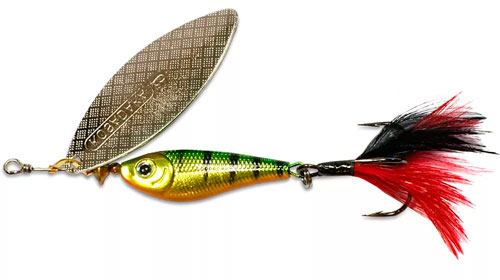
Firstly, the core weight in the shape of a fry is the most irritating to predatory fish. In most cases, the interest in the “fry” is so pronounced that there is no need to even disguise the hook with feathers and wool. Often such camouflage even worsens the bite, as it alerts the predator, diverting its attention from the most “appetizing” element of the spoon.
Secondly, the eccentric sinker prevents the spinner axis from rotating and prevents the line from twisting.
Thirdly, with a relatively heavy lead core, the spinner, compared to other spinners of its size, becomes significantly longer-range and goes deeper. For example, the lead analogue of the “nulevka” weighs 4 g instead of 2.5 g, which means that it is much easier to throw it to the asp, chub or grayling camp. In a strong current, where an ordinary spoon will quickly be carried to the surface, a heavier spinner with a lead core will go at the required depth, and this is what often encourages grayling or chub standing at the bottom to bite.
But there is a certain danger in weighting the sinker. After all, we already know about the critical weight of the core. Therefore, if you want to make such a lure yourself, you need to be especially careful in selecting the “sinker-petal” pair and taking into account all possible subtleties. For example, when moving against the stream, even a narrow petal will rotate normally, but at some angle to the current it will begin to get confused, and then you will have to take a wider petal. And if the lure needs to be carried downstream, an even wider option is needed. Moreover, the most capricious ones here are the small petals. The larger the petal, the better it works, and the average Long already rotates stably even in calm water.
With spinner fish, I have more than once had excellent success hunting asp, chub, perch and grayling, and on fast northern rivers there was often no alternative to this bait. This is why I tend to believe that lead core fish are the optimal way to improve body shape for spinners. But, of course, not the only one.

Let’s not forget that the core is not only a sinker and a “body”, it can also successfully perform other functions.
Want to have an acoustic core weight? Then carve an exact resemblance of the “bell” or come up with your own version. Acoustic elements may also be on other parts. For example, some craftsmen make additional longitudinal holes on the bumper. The micronoises that arise in the holes undoubtedly attract fish.
If you are a supporter of “fragrant” baits, try making some kind of container weight.
You can put dots or stripes on a regular sinker, or paint it completely. Among my friends there are ardent supporters of Super Vibrax turntables with red or blue bells. And in the “rattle beetle” the sinker imitates a larva and is painted in different colors to match different insects. And this approach is, of course, justified.
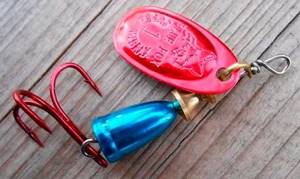
Now let's talk about spinners with a weight-head .
In these models, it is also possible to optimally adapt the sinker to specific conditions. It is especially important to choose the correct sinker weight.
For example, the heaviest model “Morrum” weighs only 18 g. However, I had to use turntables with heads up to 50 g, and this is not the limit! There is only one way out - to find a suitable sinker and “fasten” the desired spinner to it.
Another example: our head weighs 18 g and at the usual rate of wiring it plows the bottom. We lead it faster - the fish becomes wary and does not bite. And the neighbor with a 12-gram spoon catches and catches. What to do if there is no set of sinkers?
Lead is a very soft material, so even when fishing you can quickly lighten the head using wire cutters and a file. And sometimes it even changes shape. For example, some anglers prefer not a “standard” fish head shaped sinker, but a “mirror” one with a weighted front, such as the “Minnow Chaser”. It is believed that this shape gives more active vertical play and is better suited for wavy and stepped retrieves.
There are fans of a long weight-head - in the shape of a fry or a horn. In some conditions, just such a sinker turns out to be optimal, and it doesn’t hurt us all to remember this.
In some cases, painting the head weight red, yellow or black is useful. In this case, it seems that the “fish” is dragging some kind of “piece”. And vice versa, the black sinker is invisible against the background of the muddy bottom.
When considering “big-headed” spinners, we must not forget that the hook is attached to the “body”, so it is the body that needs to be made the most attractive element of the spoon. And this deserves a special discussion.
Body imitation on a spinner
The highlighting of the body and tail on the bait can be done with various elements. The most famous spinners, Morrum and Lusox, have either silver beads with a red feather fly or red cambric with a red wool tassel.
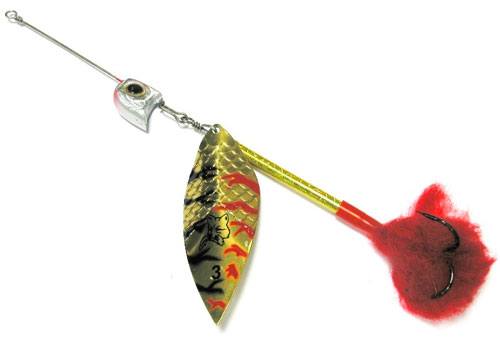
But the most versatile option, in my opinion, is a combination of light cambric and a bunch of white goat hair. This pair of elements quite accurately resembles a fry, and therefore attracts almost all of our predators. It’s not for nothing that this option is used in most Ukrainian “Master” spinners (Fig. 10).

Fig. 10. Spinner "Master".
However, you often have to fish at great depths, and also in turbid water. How to make your body even more noticeable? Here, for example, is just one of the possible paths that I went through from my own experience.
I started by putting a larger diameter cambric on my spinners with weighted heads, and replaced the goat hair, which I didn’t have, with a shiny tassel of Christmas tree “rain.” By the way, under it, the hook does not rust as quickly as under wool. Happened! And I didn’t lose any of my catches.
Then the idea arose to make the body even larger, and in addition to make it buoyant, because fishing “on the bottom” is fraught with frequent snags. A “float” was needed that would support the tee in a suspended state, preventing it from falling to the bottom and catching all kinds of dirt, and even snags.
A “carrot” made of polyethylene foam, lowered into a bathtub filled with water, regularly supported the tee with “rain” above the very bottom. This is how two options appeared: with a propeller and with a regular petal (Fig. 11).
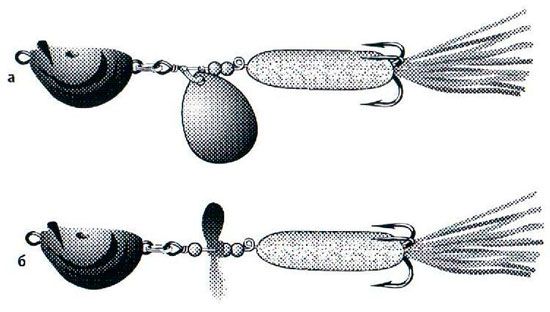
Fig. 11. Spoons with a volumetric float body: a) with a petal, b) with a propeller.
To prevent the front part of the float body from quickly getting wet, since a petal or propeller is constantly “pressing” on it, it was necessary to make an additional turn on the frame - a support for the rotating element, so that the load would no longer be transferred to the soft part.
At the spring Akhtuba, the new products exceeded all my expectations. The pike perch clearly preferred them to everything I had caught so far. Even when the bite on standard baits stopped, spinners with a float body continued to work, work and work.
While fishing, one interesting feature emerged. The floating element slightly changed the trajectory of the retrieve: since the float body tried to float, the spinner went as if inclined, and the tee was higher than that of a conventional model.
It turned out that this is not a hindrance for pike perch, but rather the opposite, because it usually attacks prey from behind and from above, often even pressing the bait to the bottom. This means that a slightly inclined position of the hooks is more advantageous than a simply horizontal one.
However, the angle of the bait should not be excessively large, otherwise the body rises so much that it interferes with the correct operation of the petal. This can happen if polyethylene foam is replaced with a more “buoyant” material, such as polystyrene foam. Of course, excess buoyancy can be easily removed if you work on the bait with a knife or scissors, that is, you can adjust it even on a pond.
I admit, I have not yet fully figured out which option works better - with a propeller or with a petal.
An equal number of fish were caught on them and their sizes were approximately the same. However, it seems to me that active pike perch still prefers a rotating petal; probably the “fanged” one hears its play more clearly. But with a weak bite, the propeller shows the best results.
Small perch baits, as a rule, require a more “buoyant” material for the float body. For example, for me, a 2 cm long foam plastic olive in combination with a tail of red thread, petal No. 1 and tee No. 6 worked better for the “striped” one.
Inspired by the successful tests, I began to offer the fish a variety of body options. First, I put a regular hard silicone fish on a spoon with a head. But, despite its complete natural resemblance, the predators treated it somehow coolly.
Next in line was the foam fish. Predators received it more favorably, and pike, perch, pike perch, and asp were “noted” in the catches.
It’s the turn of the “octopus” (Fig. 12).
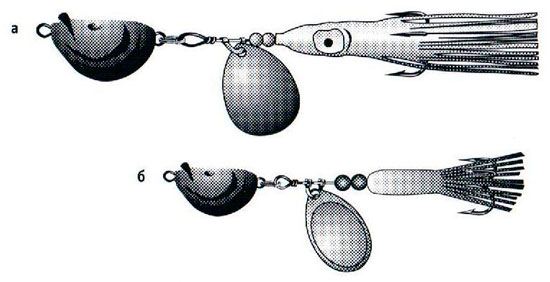
Fig. 12. Front-loaded spinner with an “octopus” and “squid” body.
It turned out to be just what we needed. Despite the relatively large size of the bait, even small perches eagerly pecked at it. The pike perch recognized the “octopus” literally from the first cast, and this happened after a long break in biting. On the same day, a three-kilogram pike was caught on the “octopus”, and the next morning a small catfish pecked.
I think that the secret of the “octopus’s” catchability lies in its special, incomparable game. A well-functioning petal strongly swirls the water behind it, and in this “trail” the long tentacles sway and flow as if alive. And if you conduct such a lure with a slightly wavy wire, then it will simply be impossible to believe that this is not a living creature, but an artificial bait. Large pike especially respect wavy wiring. And several seasoned predators, caught from the depths in difficult times literally just before the freeze-up, made the octopus spoon my favorite pike bait.
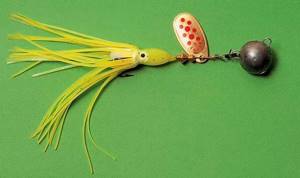
I wanted to have similar small-sized spoons, but only fairly large silicone octopuses were on sale. I had to use simpler options - “squids” (they are also called “tubes”).
Small spinners with a “squid” body also turned out to be extremely successful.
Equipped with weight heads weighing 6-10 g and easily rotating petals, the new products work even in free fall, while the “squid” tentacles tremble slightly and the small body sparkles appetizingly (Fig. 12b). When the water temperature drops sharply in the fall, perch ceases to be interested in straight-running spinners. And falling squid spoons catch striped fish all the way to the ice.
From the same “octopus” and “squid”, mounted on a rod with an elongated lead weight, an excellent pinwheel with a core was obtained (Fig. 13).
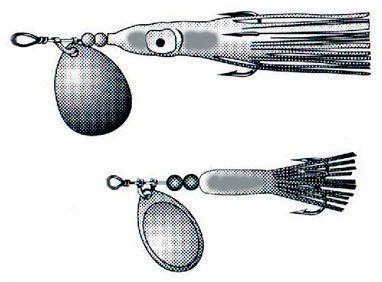
Fig. 13. Spinner with an “octopus” and “squid” core and body.
Practice has shown that such “flesh” options are on average 25% more catchy than a spoon without a silicone “shirt”. The reason, it seems to me, is clear - it is a more familiar shape and color “like a natural fry” for a predator.
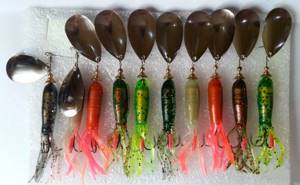
I am sure that any angler, if desired, can come up with his own, no less interesting options.
Tee - additional bait
Let's consider several ways to not only disguise the tee, but also make it an additional bait (Fig. 14).
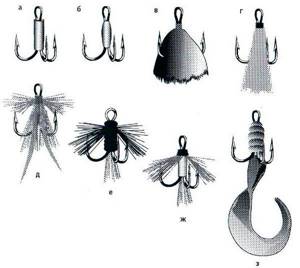
Fig. 14. Tee equipment: a) cambric, b) thickening on the fore-end, c) tassel of thread, d) hair tail, e) feather tail, f) shaggy insect fly, g) smooth whitebait fly, h) twister.
Some of them can significantly increase the catchability of our spinners.
Cambric. A bright red piece of insulation on the forend of the tee attracts the attention of the predator and creates, as it were, an “aiming point” for it (Fig. 14a). This is the simplest and most frequently used remedy, which, however, has a serious drawback: water is retained under the tube, which leads to the appearance of rust. An assembled tube made of multi-colored pieces looks even more noticeable.
The fore-end is painted with orange fluorescent paint on a layer of epoxy resin previously applied for thickening (Fig. 14b). This forend is brighter than cambric and does not rust.
of bright red threads It is desirable that such a “tail” be at least a little playful. To do this, it is better to make it not from yarn, but from individual threads. After fishing, they need to be squeezed out and dried quickly so that the tee does not rust.
The hairy tail of white, gray or other colors imitates the tail of a fish (Fig. 14d). Sometimes instead of wool, and sometimes together with it, “sparkling” threads or even Christmas tree “rain” are used.
The tail of feathers on the tee attracts fish even better (Fig. 14e). When guiding, it “breathes”, that is, it plays with all the hairs and provokes the predator to grab it. For example, red and yellow colors attract perch and ide, and white and gray attract asp, pike, and pike perch.
A full-fledged fly on a tee (Fig. 14e, g) is tempting for many fish. Hairy flies are especially good for insectivores: ide, chub, asp, grayling, trout; and shiny versions in the form of fry are suitable for any predators.
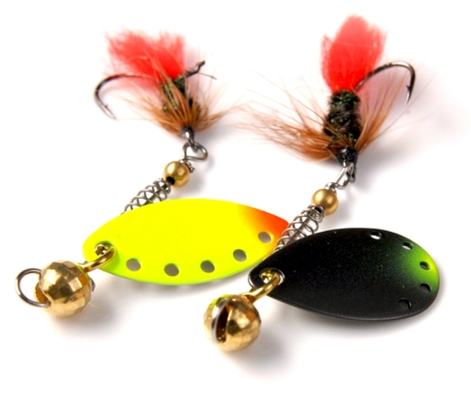
The twister on the tee (Fig. 14h) is especially popular with perch and pike. The twister itself is an excellent bait, and together with the sounding spinner it makes an ideal pair. To begin with, two colors are enough: white and red. Red color is used in sunny weather, white - in cloudy weather. If the predator is actively biting and in low light, you can use a more noticeable yellow color instead of white.
The twister must be correctly placed on the tee so that it does not bulge. To do this, a small longitudinal incision is made in the back of the body, into which a tee is inserted, piercing the body of the bait along the axis with its ear.
But all these improvements become absolutely useless in the grass or dense snags - where, as a rule, most predators stay. Therefore, we will definitely need non-tangling hooks.
Non-snagging hooks. There are ready-made single hooks with a safety eyelet on sale, but non-hooking tees are quite rare. However, if you wish, you can make them yourself.
Three pieces of thin elastic wire (I use strings for musical instruments) are bent in half, then glued and wound to the fore-end with the mustache (tips) facing up. Then these three pairs of whiskers are bent from the ring to the stings of the tee (a pair per hook) in such a way as to protect the sting from being caught. Now - anywhere!
How to make a rotating spoon with your own hands
The easiest way to make a front-loaded spinner or tail spinner at home. A spinner with an axial core and a petal on a clamp is the pinnacle of craftsmanship. To make it you will need:
Materials:
- steel wire with a diameter of 1.5-1.7 mm;
- sheet of non-ferrous metal with a thickness of 0.5-0.7 mm;
- brass rod with a diameter of 7 mm;
- sheet of thin metal;
- wooden block;
- metal and glass beads with a through hole;
- treble hook;
- winding ring.
Tools:
- hacksaw or grinder;
- wire cutters;
- round nose pliers;
- file;
- drill;
- sandpaper;
- grinding paste.
the drawing in advance in order to maintain all the necessary dimensions and proportions.
The manufacturing process is as follows:
- Cut a piece of wire to the required length.
- Cut out the petal.
- A matrix is cut out in a wooden block.
- Apply the petal and use a wooden hammer to give it the desired convexity.
- A through hole is drilled in a brass block to obtain a core.
- A loop is formed at the end of the wire.
- A clamp is made from thin sheet metal and a petal is placed on it.
- The following are alternately put on the wire: a clamp with a petal, beads and a core.
- A loop is formed at the end of the wire.
- A winding ring with a tee is attached to the bottom loop.
All parts are processed and polished before assembly.
Homemade turntable of the simplest design
A primitive rotating spoon can be made quite quickly. In the simplest version, the sequence of actions will be as follows:
- The wire is bent with thin-nose pliers into some kind of fastener, a hook is put on, and then it is fixed, as well as the end of the wire with a heat-shrinkable tube.
- Thick copper wire wound around a rod, or beads of a suitable size, can be used as a core.
- The petal can be made from a teaspoon, or taken ready-made from an old spoon.
- You can put the petal on the axis either using a clamp or without it (the stability of play with a clamp is still higher).
Such a spinner is quite a working bait, although not very reliable - the design, while simplifying its manufacturing, has acquired a number of disadvantages, as a result of which twisting of the fishing line, jamming of the petal and the hook getting caught by the leash will be commonplace.
How to modify a purchased bait
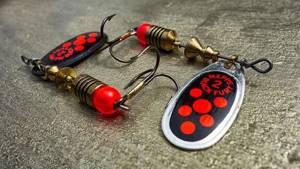
Already purchased spinners have to be modified if the spinner does not work well, namely, it does not start or starts unstable. To do this, you have to disassemble the turntable and change something. Accordingly, for this you will need:
Materials:
- steel wire;
- beads;
- parts from unnecessary turntables, for example, a bump stop.
Tools:
- wire cutters;
- pliers;
- round nose pliers.
It is advisable to have a drawing of a catchy branded spinner and adjust your actions in accordance with it.
The process of finalizing the spinner looks like this:
- Bite off the top loop from the axial rod of the turntable.
- They disassemble the spinner.
- They are trying to change the shape of the petal.
- They are trying to replace the beads.
- Assemble the spoon on the new axis.
- Check its operation in a container of water.
In addition to modifying the turntable, you can apply tuning, which consists of equipping the tee with a fly and changing the color of the petal. The color can be changed using waterproof markers or by gluing pieces of reflective tape cut out in the shape of a petal.
Homemade do-it-yourself spinner, which is great for catching pike

Today, together we will make a simple rotating spoon with our own hands. At home you can make such a spinner in 10 minutes (if you have the tools and material).
Tools and material for a homemade catching spinner for pike
What do we need for a homemade turntable?
Material:
- a piece of tin (the most affordable and suitable is a lid for screwing on jars - remember the preparations for the winter),
- winding ring,
- beads,
- paper clip,
- tee,
- sinker,
- red cambric.
Tools:
- pliers,
- scissors,
- ruler,
- marker,
- awl,
- sandpaper or file.
Useful and interesting: A tricky way to install gear for catching perch on a retractable leash!
Making a homemade catchy rotating spoon for pike
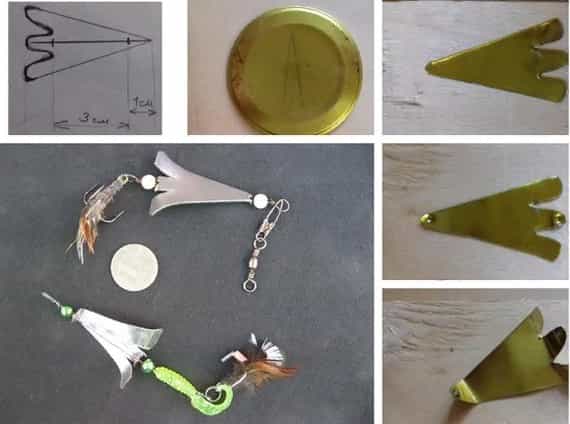
- The first step is to draw up a drawing of the future spinner and transfer it with a marker to the tin lid.
- Then we carefully cut out our workpiece. It turns out the basis of the future spinner. By the way, in common people such a spinner is called a pike triangle.
- We make holes in the upper corner of the triangle and in the central petal of the tail using an awl.
- We bend the outer tails at an angle of 45 degrees - like a propeller screw. And we bend the central tops with holes at 90 degrees in one plane.
Now we can start decorating the spoon - we’ll paint it with silver manicure varnish so our spoon will play effectively in the water.
- Take a paper clip and bend it into a straight wire. We make a loop at the end.
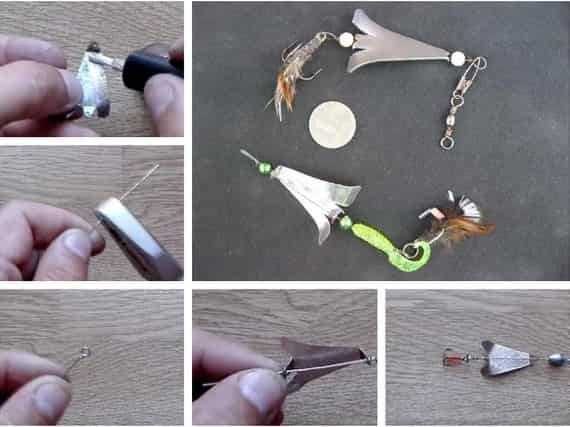
- We thread a sinker and a couple of beads.
- Then our homemade spoon and again a bead. At the second end of the straightened paper clip we make a loop.
- We pull the red cambric onto the tee and put on the winding ring.
- The last step is to connect our entire structure together - hang the hook on the base.
To add brightness and match the appearance of a real fish, you can paint the side tails, bent at 45 degrees, red—again, using nail polish.
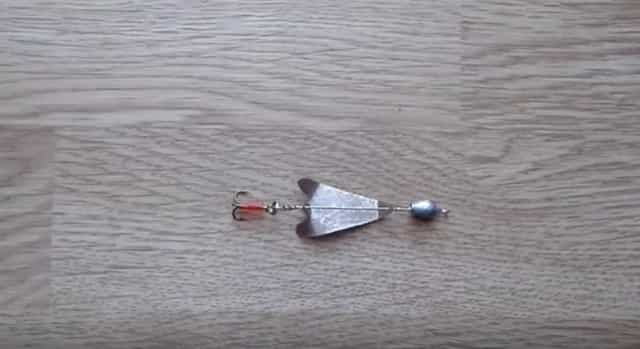
With these simple steps, we made a catchy spinner spoon for pike with our own hands.
Fishermen say that the wire from a paper clip is too unreliable, but I assure you that a pike of 2-3 kilos grabbed such a structure, and everything survived.
Secondly, some advise not to bother and buy similar Chinese spinners for future use. But, guys, aren’t you interested in whether it will work out or not? Moreover, the material is accessible and inexpensive.
To attract more predators, it is recommended to install a propeller made of the same metal in front of the turntable, and install a double tee and trim it with red woolen threads. Plus the petals – make the left and right ones wider in width.
Well, everything is in your hands. Test and experiment - then fishing luck will be on your side.
I advise you to pay attention: Is it possible to fish with a spinning rod during spawning?
Combinations for spinner bait
The combination involves adding some element to the turntable that can change its operation or increase its visual volume. The purpose of this is to increase the catchability of the bait. The most commonly used combinations are:
- fly, streamer, twister on a turntable hook. The Mepps line of spinners includes baits marked TW, in which the treble can be removed without damaging the bait;
- tandem spinner. Two turntables are connected in series either rigidly or with a flexible cable;
- a pinwheel with paired petals rotating in antiphase.
What to look for when using a spinner
When using and purchasing turntables, you should pay attention to the following characteristics:
- Color.
- Size.
- Loading.
- Rotation angle.
- Petal shape.
- Weight.
Color
By its nature, perch is not very picky about the colors of baits, so you can safely use classic colors for it: silver, red, gold and copper tints, bright colors.
As practice shows, perch reacts most to baits that have at least a small particle of red color. This could be a red petal or any other red spots that could catch the fish's eyes.
Size
When choosing the size of a spoon, you should know that the larger it is, the larger the fish it will catch, so the fisherman must first determine what kind of fish he will “hunt” and, based on this, buy a spoon. The classic size of “pinwheels” is considered to be from four to seven centimeters.
Loading
A standard “spinner” consists of a small cone-shaped weight, a ball and an additional weight for casting distance. The cone and ball function to provide free rotation of the petal. The petal itself is attached to a small bow.
The weight does not allow the spoon to dangle much in the water, so it can more smoothly and orderly perform its main task - to attract fish. In addition, spinners can be rear-loaded or front-loaded.
Rotation angle
The angle of rotation can be determined “by eye” by looking at the shape of the petal.
The petal, which has a narrow and oblong shape, has a rotation angle of about thirty degrees, therefore, due to the fact that it has low resistance, it can be used in large currents.
Spoonbaits whose petals are oval in shape usually have a rotation angle of fifty degrees. They are able to attract fish from very long distances, since they create certain sound waves with their structure.
Petal shape
The shape of the petals of spinners is:
- Round. Used in reservoirs with weak currents.
- Narrow and long. They are very effective when fishing in large currents.
- Oval and elongated. Can be used in almost all fishing conditions.
- The petal is without a clamp, which is simply attached to the base of the spoon.
Weight
It is best to use spinners of medium weight - from five to ten grams. Lighter spoons will be subject to current all the time, while heavier ones, on the contrary, will rotate poorly.
Fishing with spinners
- Perch.
The search for perch is carried out by casting the spinner in different directions until they come across a school. The wiring is uniform. Spoons with a narrow blade are more catchy. At depth they are fishing with tail spinners and front-loaded spinners with a small petal. - Pike perch.
Front-loaded turntables “pierce” the terrain. Promising places are any anomalies in the bottom topography. Wiring is stepped. - Pike.
In the shallowest waters, unloaded Mepps Lusox type spinners are used. At depths of up to 3 meters they are caught with spinners with petals of different shapes up to size 5. At depths, front-loaded turntables and stepped wiring are used. - White predators.
The chub floats on the current and should be looked for near fallen trees, in “returns” behind stones and on riffles. Ide prefers calmer water. The asp stays under steep banks. The turntable is carried out “for demolition” or against the flow with uniform wiring.
Making an inline type turntable
This is a relatively infrequent design in which clamps or bows are not used to attach the petal - it is simply put on the main rod. The stability of the game is ensured by the unique geometry of the petal, thanks to which the spinner has a fairly low rotation frequency, which is especially attractive for the same pike.
The most difficult part of creating such a turntable is making a mold, since in the case of a fairly complex geometry it will not be possible to get by with just a ball and a hammer, especially if you plan to make the petal from stainless steel. The best option is a shape that has two planes converging at an angle of about 160 degrees, and closer to the edge of the rib formed by these planes, a hole is drilled, the diameter of which is matched to the ball from the bearing.
A workpiece of a suitable size is placed on the mold and pressed into hard rubber using a vice. After the edge has been formed, the bearing is pressed with the same vice into a previously prepared part of the mold. Then a hole is drilled for attachment to the main rod. This complex lobe shape is necessary for stable low-frequency playing without a clamp.
Important! The vice will need to be quite powerful, since especially in the case of stainless steel petals, a lot of force will need to be created.
It is easier to work with copper or other soft metals; a steel mold is not necessary; a lead or wooden one may be sufficient. The core, winding rings and other structural elements are assembled in the same way as in the case of previous designs.
